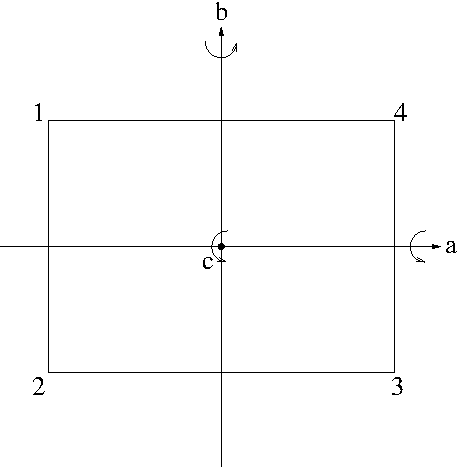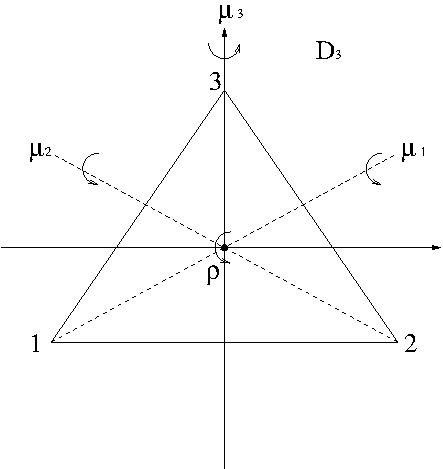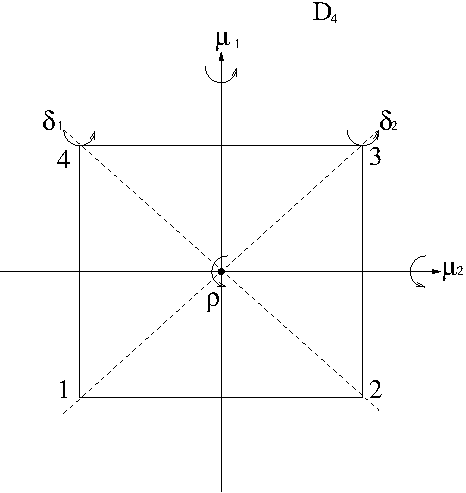In this lecture, we study subgroups. A nonempty subset $H$ of a group $G$ is called a subgroup of $G$ if $H$ itself forms a group relative to the operation $\cdot$ in $G$. If $H$ is a subgroup of $G$, we simply write $H\leq G$. Clearly $G\leq G$ and $\{e\}\leq G$. $G$ and $\{e\}$ are called trivial subgroups of $G$. Before we discuss subgroups further we need to go over some basic properties of a group as we need them.
Lemma. If $G$ is a group, then:
(a) Its identity element is unique.
(b) Each $a\in G$ has a unique inverse $a^{-1}\in G$.
(c) $\forall a\in G$, $(a^{-1})^{-1}=a$.
(d) $\forall a,b\in G$, $(ab)^{-1}=b^{-1}a^{-1}$.
The proof of this lemma is pretty much straightforward and is left to readers.
In order to show that a nonempty subset $H$ of a group $G$ is a subgroup we need to check:
1. $H$ is closed under $\cdot$, the operation in $G$. That is, $\forall a,b\in H$, $ab\in H$.
2. $e\in H$.
3. $\forall a\in H$, $a^{-1}\in H$.
Note that the associative law holds automatically. It turns out that there is a simpler criterion to check if a nonempty subset is a subgroup of a group.
Lemma. A nonempty subset $H\subset G$ is a subgroup of $G$ if and only if $\forall a,b\in H$, $ab^{-1}\in H$.
Proof. ($\Longrightarrow$) Clear.
($\Longleftarrow$) Let $a,b\in H$. Then by assumption, $aa^{-1}=e\in H$. Since $a,e\in H$, $ea^{-1}=a^{-1}\in H$. Since $b^{-1}\in H$, $a(b^{-1})^{-1}=ab\in H$. Therefore, $H$ is a subgroup of $G$.
Example. $\forall n\in\mathbb{N}\cup\{0\}$, $n\mathbb{Z}\leq(\mathbb{Z},+)$. Here, $n\mathbb{Z}=\{nx: x\in\mathbb{Z}\}$. In fact, they are all the subgroups of $(\mathbb{Z},+)$.
Definition. The cyclic subgroup of $G$ generated by $a\in G$ is $\{a^k: k\in\mathbb{Z}\}$. It is denoted by $\langle a\rangle$.
Example. Let $G$ be a group and $a\in G$. Let $C(a)=\{g\in G: ga=ag\}$. Then $C(a)\leq G$. $C(a)$ is called the centralizer of $a$ in $G$.
Example. Let $G$ be a group and let $Z(G)=\{z\in G: zx=xz\ \forall x\in G\}$. Then $Z(G)$ is a subgroup of $G$, called the center of $G$.
Example. Let $G$ be a group and $H\leq G$. $\forall a\in G$, $a^{-1}Ha=\{a^{-1}ha: h\in H\}$ is also a subgroup of $G$.
Lemma. Suppose that $(G,\cdot)$ is a group and $H$ is a finite nonempty subset of $H$. If $H$ is closed under $\cdot$, then $H$ is a subgroup of $G$.
Proof. Let $H=\{a_1,a_2,\cdots,a_n\}$. Then $\forall a\in H$, $aH=\{aa_1,aa_2,\cdots,aa_n\}\subset H$. On the other hand, if $aa_i=aa_j$ then $a_i=a_j$. So, $|aH|=|H|$. This implies that $aH=H$ and hence
\begin{align*}
a\in aH &\Longrightarrow a=aa_i\ \mbox{for some}\ i\\
&\Longrightarrow a_i=e\in H.
\end{align*}
Since $e\in aH$, $e=aa_j$ for some $j$ $\Longrightarrow$ $a_j=a^{-1}$.
Example. The symmetric group $S_3=\{1,(123),(132),(23),(13),(12)\}$ has 5 subgroups $\{1\}$, $\{1,(12)\}$, $\{1,(13)\}$, $\{1,(23)\}$, and $A_3=\{1,(123),(132)\}$. $A_3$ is called alternating group of degree 3. Cycles of length 2 such as (12), (13), (23) are called transpositions. Any permutation can be written as a product of either an even number of transpositions or an odd number of transpositions. If a permutation is a product of an even number of transpositions, the permutation is called an even permutation. If a permutation is a product of an odd number of transpositions, the permutation is called an odd permutation. The identity permutation 1 is an even permutation as $\begin{pmatrix}
1 & 2 & 3\\
1 & 2 & 3 \end{pmatrix}$ can be written as (12)(21)(23)(32)(31)(13). The permutation (123) can be written as (12)(13). So, (123) is an even permutation. Similarly (132) is an even permutation as well. So it turns out that the alternating group $A_3$ is the set of all even permutations. In general, the set $A_n$ of all even permutations of $\{1,2,3,\cdots,n\}$ form a subgroup of the symmetric group $S_n$. Remember that $S_n$ has order $n!$. Since there are exactly the same number of even permutations and odd permutations, the alternating group $A_n$ of degree $n$ has order $\frac{n!}{2}$.
Example. $\mathrm{SL}(n,\mathbb{R})=\{A\in\mathrm{GL}(n,\mathbb{R}): \det A=1\}$ is a subgroup of the general linear group $\mathrm{GL}(n,\mathbb{R})$ of degree $n$. $\mathrm{SL}(n,\mathbb{R})$ is called the special linear group of degree $n$.



